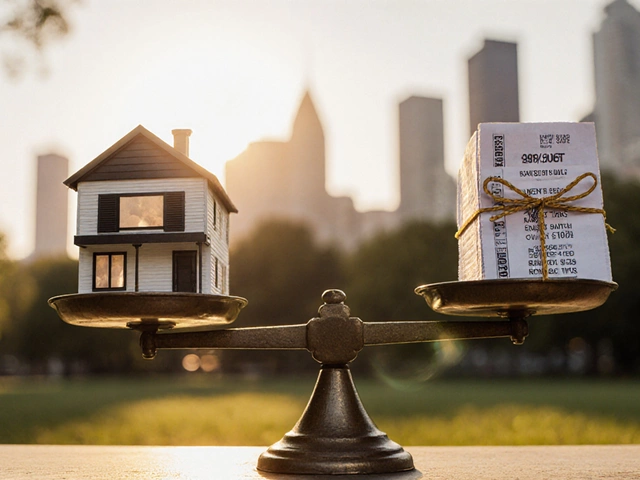Riskiest Asset Class in Commercial Property Sale: What You Need to Know

Chasing high returns in commercial property? It's easy to get caught up in the excitement, but the numbers can blindside even experienced investors. Some asset classes look like gold mines, especially in boom years, but a couple of rough quarters can turn things upside down fast. So which property types actually put your money most at risk?
If you're thinking every office tower or strip mall is equally risky, think again. Each property type comes with its unique set of challenges, and some are way more unpredictable than others. For example, just look at how coworking spaces or downtown retail struggled during the 2020s lockdowns. Tenants vanished, cash flows dried up, and values dropped. The lesson: not all commercial properties play by the same rules when things go wrong.
People often focus on returns, but that's only half the story. Understanding which asset class is truly the riskiest—and why—makes all the difference between winning big and losing sleep. Ready to find out where the real danger zones are in commercial real estate?
- Defining Asset Classes in Commercial Property
- Why Some Assets Are Riskier Than Others
- Spotting the Riskiest Asset Class
- Real-World Examples: When Risk Turns Real
- How to Reduce Your Risk Exposure
- Key Takeaways for Smart Investors
Defining Asset Classes in Commercial Property
Commercial property covers a lot more than just office buildings. When people talk about asset classes in this space, they're breaking it down into categories based on how the property is used and what kind of cash flow or risk comes with it. Knowing these asset classes helps you compare deals, balance your portfolio, and spot where things could get messy down the road.
The four main commercial property types are:
- Office space: This means everything from downtown skyscrapers to suburban complexes. The tenant mix and location make a huge difference in stability and risk.
- Retail: Think shopping centers, strip malls, and standalone stores. These properties rely heavily on how well the tenant’s business performs and shifts in consumer behavior.
- Industrial: This covers warehouses, distribution centers, and manufacturing spaces. E-commerce has made some of these more attractive, but not all are created equal.
- Multifamily: These are apartment complexes, not single-family homes. Population trends and local job markets really affect these assets.
There are also more niche categories like hotels, self-storage, and medical offices, but they usually see less overall volume in the commercial property sale world. What ties all these asset classes together? Each one has its own reward and risk profile, shaped by market trends, tenant type, and lease structure. You’ve got to know what you’re dealing with before putting your money in.
Why Some Assets Are Riskier Than Others
Not every commercial property is created equal, and risk varies a lot between types. Let's break down a few reasons why one asset class can be way riskier than another.
- Tenant Dependence: If a property relies on a single big tenant (think anchor stores in malls or one major office lease), the risk shoots up. If that anchor leaves, the place can stay empty for months, which means no rental income for you.
- Market Fluctuations: Some properties, especially retail and hospitality, are way more sensitive to swings in the economy. During a downturn, shoppers cut back and vacations get delayed, so these properties can bleed cash fast.
- Location Volatility: A trendy neighborhood today can decline tomorrow. Hotels in tourist hotspots or offices in city centers can lose value quickly if the area falls out of favor or if new supply floods in and drives rents down.
- Regulatory Changes: Zoning updates, new taxes, or short-term rental rules can suddenly make some property types less profitable, or even force them to shutter.
To give you a quick snapshot, here’s how risk compares across popular commercial property types:
| Asset Class | Main Risk Factors | Historical Vacancies (%) | COVID-19 Impact |
|---|---|---|---|
| Office | Tenant flight, remote work trends | Up to 18% | High – Major cities saw >20% vacancies |
| Retail | E-commerce, anchor tenant loss | Up to 12% | High – Especially malls and luxury retail |
| Hospitality | Economic cycles, seasonal variation | Up to 25% (off-season) | Extreme – Occupancy down 50% in 2020 |
| Industrial | Shifts in supply chain, tenant mix | 4-7% | Low – E-commerce boosted demand |
Notice how hotels and retail properties are seriously impacted when the economy takes a dive, compared to industrial spaces, which usually hold steady or even grow thanks to e-commerce. So chasing higher returns in these riskier types can seriously backfire if you don’t keep your eyes open for these warning signs.
The riskiest asset class often shifts with the times, but those properties that depend on consumer spending and trends—hotels, malls, high-end retail—will always be balancing on a thin line when things get shaky.
Spotting the Riskiest Asset Class
If you ask a group of real estate pros about the riskiest asset class in commercial property, you’ll hear one answer again and again: hospitality. Think hotels, motels, anything that depends on people paying for nights. Why? Revenue stops overnight when guest demand drops. Unlike office or industrial leases, which are often locked in for years, hotels live or die by daily occupancy rates.
Hotels can thrive in good times, filling up at high rates, but the downside hits hard. For instance, during 2020, nationwide hotel occupancy in the U.S. fell below 45% for months—far below the breakeven point for most operators. That’s compared to industrial properties, which barely flinched and kept steady tenants shipping goods. Here’s a quick rundown of average occupancy and volatility, using pre- and post-pandemic data:
| Property Type | 2023 Occupancy (%) | 2020 Occupancy (%) | Lease Length (Avg. Years) |
|---|---|---|---|
| Hotels | 63 | 44 | Nightly |
| Retail | 91 | 87 | 3-10 |
| Office | 84 | 81 | 5-10 |
| Industrial | 95 | 93 | 5-15 |
See the difference? Hotels had the wildest swing. That up-and-down ride is where risk comes from. Even during normal years, hotel values flip faster because they rely on travel, tourism, and business trips—all easy targets for economic shocks.
But hotels aren’t the only risky spot. Niche sectors, like student housing and senior living, come next. These rely on very specific renters: students or older folks. When universities went remote or COVID-19 hit senior centers, owners lost tenants fast. Compare that to offices, which may lose some demand in a recession, but most companies still pay rent under contract.
If you spot a property where income depends on short stays, seasonal visitors, or a narrow type of renter, it’s likely riskier. For more stability, look for leases that tie tenants in for years and don’t swing with daily headlines.

Real-World Examples: When Risk Turns Real
If you want proof that commercial property isn’t always a safe bet, let’s check out what’s happened in the last few years. Take offices, for example. When COVID hit in 2020, big cities like New York and San Francisco saw office vacancy rates skyrocket. According to CBRE, by late 2023, New York City's office vacancy rate was above 22%—almost double what it was in 2019. That meant empty buildings, unpaid rents, and falling values—bad news if you owned or financed this kind of property.
Then there’s retail. Remember all the hype around shopping malls in the 2000s? Fast forward to 2024, and it’s become one of the riskiest asset class bets. Online shopping surged, stores closed, and even giants like Westfield ditched their US malls. According to Statista, over 2,800 retail stores closed in the first half of 2024 alone. Malls in places with weak local economies lost value fast, leaving investors stuck with properties that nobody wanted to rent—or buy.
Hotels might look like a glamorous investment, but they’re not immune. Travel freezes in 2020 had a brutal impact. The American Hotel & Lodging Association reported hotel revenues in the U.S. dropped about 50% that year. Even in 2025, some cities haven’t bounced back because business travel still lags behind pre-pandemic levels.
Here’s a quick look at some headline numbers that show what happened when trends turned against these assets:
| Asset Type | 2023/2024 Vacancy/Closure Rate | Biggest Recent Risk Factor |
|---|---|---|
| Office | 22% vacancy in NYC | Remote Work |
| Retail | 2,800+ store closures (H1 2024) | Growth of E-commerce |
| Hotels | 50% revenue drop (2020) | Pandemic-driven travel freeze |
So, what can you actually do if you’re looking at these properties? Don’t just fall for past performance or shiny marketing materials. Check the fundamentals. Is the tenant dependable? Are there backup plans if a store goes dark or a company stops paying rent? Talk to owners and ask actual questions: "How did your property do in 2020?" and "What’s your contingency plan if the anchor tenant leaves?"
These examples prove one thing—real estate risk isn’t just theory. The biggest hits in commercial property happen when the world changes fast, and buildings can’t keep up.
How to Reduce Your Risk Exposure
If you're eyeing commercial property but don't want to wake up in a cold sweat, some real steps can help you dodge major headaches. You can't kill all risk, but you can definitely lower it with smart moves.
The first line of defense: diversify. If you only own one busy retail space and it suddenly empties, you're stuck. By spreading your money across different property types—like a mix of warehouses, small offices, and maybe even some industrial—you’re not betting everything on just one winner.
Research is non-negotiable. Dig into vacancy rates, tenant default stats, and local market cycles before you sign anything. For example, according to CBRE’s 2024 Global Real Estate Market Outlook, suburban office vacancies hit nearly 20% last year, while industrial stayed below 5%. You can’t ignore numbers like that.
- Pick properties in prime locations. Even during downturns, good locations recover faster.
- Vet your tenants. A big-name anchor tenant with a long lease can save you from sleepless nights.
- Understand lease terms. Short leases with small businesses bring more turnover—and more risk.
- Keep cash reserves. It cushions you during unexpected repairs or vacant months.
- Consider working with a property manager. They can spot small problems before they become financial disasters.
If you're wondering how much different assets can fluctuate, check this out:
| Asset Class | Typical Vacancy Rate (%) | Typical Lease Length (years) |
|---|---|---|
| High-Street Retail | 10-15 | 5-7 |
| Suburban Office | 18-22 | 3-5 |
| Industrial/Warehouse | 3-7 | 7-10 |
| Hospitality | 20-30 | N/A (Nightly) |
It's clear that commercial property sale involves real risk, but with the right moves, you can tip the scale in your favor. Stay flexible, keep learning, and don’t fall for the hype without checking the numbers first. If you're careful, your portfolio can survive even the rough patches.
Key Takeaways for Smart Investors
If you want to keep risk in check while hunting for good deals in commercial property, you have to think beyond just location or price. Smart investors recognize the real differences between asset classes—office, retail, industrial, and multifamily—and know exactly where the pitfalls are hiding. The riskiest asset class in commercial property sale often shifts with the market, but there are some hard truths that hold up no matter what:
- Volatility is higher in certain property types. For example, office space has seen huge swings lately, especially after remote work exploded. Vacancy rates for major U.S. cities topped 19% in 2024, compared to only 6% for warehouses.
- Tenant stability makes or breaks your returns. Single-tenant buildings (think chain restaurants) can turn into a nightmare if the tenant leaves, leaving you with 100% vacancy overnight.
- Location trends are always shifting. What’s hot one year can be ice cold the next—just look at urban retail, which got hammered in cities like San Francisco and Chicago while some suburban spots thrived.
Check out how different property types stacked up on risk last year:
| Asset Type | 2024 Avg. Vacancy Rate | Avg. Annual Return | Market Volatility |
|---|---|---|---|
| Office | 19% | 2.1% | High |
| Retail (Urban Core) | 13% | 3.8% | High |
| Industrial | 6% | 6.2% | Moderate |
| Multifamily | 7% | 5.7% | Low |
So, what’s the move if you’re a hands-on investor? Keep an eye on these strategies:
- Spread your risk. Avoid putting all your money into one asset class that's in a tough market cycle.
- Dig into tenant quality. Look at lease lengths and credit ratings, especially on single-tenant deals.
- Don't chase fads. The market moves in cycles, and what's popular now could be risky later—think about all the hype around coworking spaces just before things crashed.
Paying attention to these trends and stats doesn’t guarantee success, but it can help you sidestep the biggest traps most investors fall into. Stick to facts, not buzz, and don't underestimate how fast things can change in commercial real estate.









Write a comment